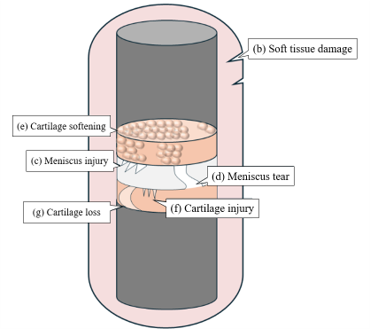Non-Invasive Monitoring of Knee Osteoarthritis Severity Using Vibration Stimulation
DOI:
https://doi.org/10.46604/peti.2024.14079Keywords:
non-invasive monitoring, frequency response function, knee osteoarthritis, vibration stimulationAbstract
This study aims to explore the application of vibration stimulation for the early detection and assessment of knee osteoarthritis severity, using a porcine knee joint. Accelerometers are attached to the femurs and tibias to measure vibratory responses under simulated osteoarthritic conditions. Frequency response functions are generated from the acceleration data and quantified using the root mean square deviation (RMSD) relative to baseline conditions. To ensure the reliability of the results, a coherence filter is applied, confirming significant differences across various stages of joint injury. The RMSD analysis demonstrates the technique's ability to detect phase differences, particularly within the 1000 Hz frequency range. These findings suggest that vibration stimulation could be a feasible non-invasive diagnostic method for assessing osteoarthritis severity in humans. This study highlights the potential of vibration-based diagnostics as an innovative approach for the early detection of osteoarthritis.
References
H. Long, Q. Liu, H. Yin, K. Wang, N. Diao, Y. Zhang, et al., “Prevalence Trends of Site-Specific Osteoarthritis from 1990 to 2019: Findings from the Global Burden of Disease Study 2019,” Arthritis Rheumatology, vol. 74, no. 7, pp. 1172-1183, 2022.
SkyQuest, “Global Knee Replacement Market Size, Share, Growth Analysis, By Procedure Type, By Component-Industry Forecast 2024-2031,” https://cn.gii.tw/report/sky1461491-global-knee-replacement-market-size-share-growth.html, accessed on 2024. (In Chinese)
T. Sivakumari and R. Vani, “Performance Analysis of Alexnet for Classification of Knee Osteoarthritis,” NeuroQuantology, vol. 20, no. 19, pp. 1686-1692, 2022.
H. K. Jeong, M. B. Pouyan, D. C. Whittingslow, V. Ganti, and O. T. Inan, “Quantifying the Effects of Increasing Mechanical Stress on Knee Acoustical Emissions Using Unsupervised Graph Mining,” IEEE Transactions on Neural Systems and Rehabilitation Engineering, vol. 26, no. 3, pp. 594-601, 2018.
R. Gong, K. Hase, H. Goto, K. Yoshioka, and S. Ota, “Knee Osteoarthritis Detection based on the Combination of Empirical Mode Decomposition and Wavelet Analysis,” Journal of Biomechanical Science and Engineering, vol. 15, no. 3, article no. 20-00017, 2020.
A. Machrowska, R. Karpinski, M. Maciejewski, J. Jonak, and P. Krakowski, “Application of Eemd-Dfa Algorithms and Ann Classification for Detection of Knee Osteoarthritis Using Vibroarthrography,” Applied Computer Science, vol.20, no. 2, pp. 90-108, 2024.
R. Karpiński, P. Krakowski, J. Jonak, A. Machrowska, and M. Maciejewski, “Comparison of Selected Classification Methods Based on Machine Learning as a Diagnostic Tool for Knee Joint Cartilage Damage Based on Generated Vibroacoustic Processes,” Applied Computer Science, vol. 19, no.4, pp. 136-150, 2023.
C. N. Teague, J. A. Heller, B. N. Nevius, A. M. Carek, S. Mabrouk, F. Garcia-Vicente, et al., “A Wearable, Multimodal Sensing System to Monitor Knee Joint Health,” IEEE Sensors Journal, vol. 20, no. 18, pp. 10323-10334, 2020.
M. Safaei, N. B. Bolus, D. C. Whittingslow, H. K. Jeong, A. Erturk, and O. T. Inan, “Vibration Stimulation as a Non-Invasive Approach to Monitor the Severity of Meniscus Tears,” IEEE Transactions on Neural Systems and Rehabilitation Engineering, vol. 29, pp. 350-359, 2021.
T. Takroni, L. Laouar, A. Adesida, J. A. W. Elliott, and N. M. Jomha, “Anatomical Study: Comparing the Human, Sheep and Pig Knee Meniscus,” Journal of Experimental Orthopaedics, vol. 3, article no. 35, 2016.
A. C. Altunışık, F. Y. Okur, S. Karaca, and V. Kahya, “Vibration-Based Damage Detection in Deam Structures with Multiple Cracks: Modal Curvature vs. Modal Flexibility Methods,” Nondestructive Testing and Evaluation, vol. 34, no. 1, pp. 33-53, 2019.
Z. Mao and M. Todd, “Statistical Modeling of Frequency Response Function Estimation for Uncertainty Quantification,” Mechanical Systems and Signal Processing, vol. 38, no. 2, pp. 333-345, 2013.
V. Giurgiutiu and A. Zagrai, “Damage Detection in Thin Plates and Aerospace Structures with the Electro-Mechanical Impedance Method,” Structural Health Monitoring, vol. 4, no. 2, pp. 99-118, 2005.
G. Marsaglia, W. W. Tsang, and J. Wang, “Evaluating Kolmogorov’s Distribution,” Journal of Statistical Software, vol. 8, no. 18, pp. 1-4, 2003.
M. E. Rice and G. T. Harris, “Comparing Effect Sizes in Follow-Up Studies: ROC Area, Cohen’s d, and r,” Law and Human Behavior, vol. 29, no. 5, pp. 615-620, 2005.
J. M. Liu, Y. F. Xu, and W. D. Zhu, “New Coherence Function with Measurements of One Sampling Period,” Mechanical Systems and Signal Processing, vol. 88, pp. 354-376, 2017.
U. Meier, “A Note on the Power of Fisher’s Least Significant Difference Procedure,” Pharmaceutical Statistics, vol. 5, no. 4, pp. 253-263, 2006.
J. H. Kellgren and J. S. Lawrence, “Radiological Assessment of Osteo-Arthrosis,” Annals of the Rheumatic Diseases, vol. 16, no. 4, pp. 494-502, 1957.
J. Cohen, Statistical Power Analysis for the Behavioral Sciences, 2nd ed., New Jersey: Lawrence Erlbaum Associates, 1988.
Y. Maximov, Y. Legovich, and D Maximov, “Frequency Characteristics of Viscoelastic Damper Models and Evaluation of a Damper Influence on Induced Oscillations of Mechanical System Elements,” Meccanica, vol. 56, pp. 3107-3124, 2021.

Published
How to Cite
Issue
Section
License
Copyright (c) 2024 Takeshi Tokoshima, Kazunori Hase, Rui Gong, Makoto Yoshida

This work is licensed under a Creative Commons Attribution-NonCommercial 4.0 International License.
Submission of a manuscript implies: that the work described has not been published before that it is not under consideration for publication elsewhere; that if and when the manuscript is accepted for publication. Authors can retain copyright of their article with no restrictions. Also, author can post the final, peer-reviewed manuscript version (postprint) to any repository or website.

Since Oct. 01, 2015, PETI will publish new articles with Creative Commons Attribution Non-Commercial License, under The Creative Commons Attribution Non-Commercial 4.0 International (CC BY-NC 4.0) License.
The Creative Commons Attribution Non-Commercial (CC-BY-NC) License permits use, distribution and reproduction in any medium, provided the original work is properly cited and is not used for commercial purposes







